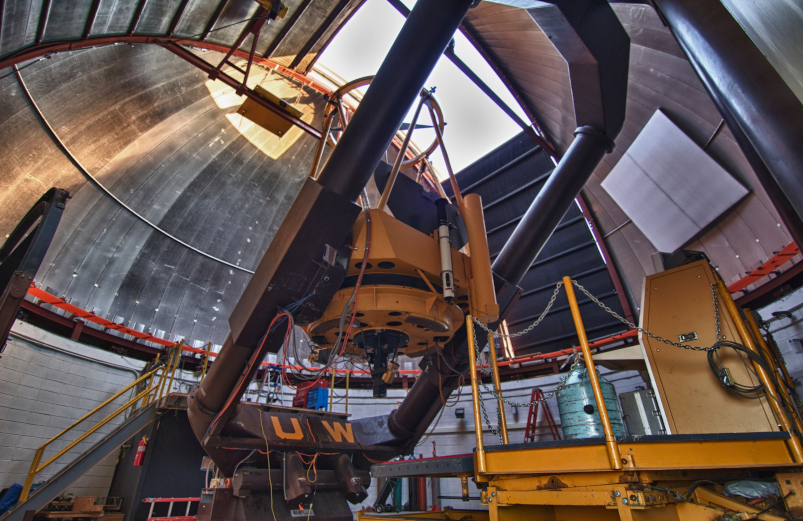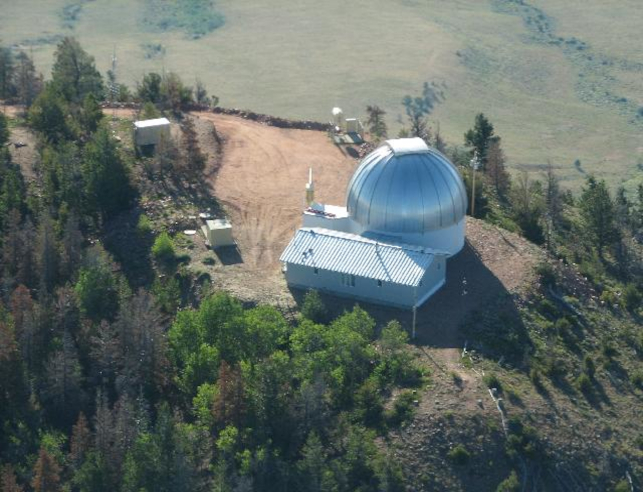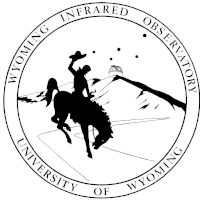Cards Carousel Slider
History
WIRO was completed in September, 1977 for $1.6 M as a partnership between the University of Wyoming (60%) and the National Science Foundation (40%). At the time it was one of the largest observatories in the world. It was briefly the largest infrared telescope. This 25-minute video by founder Prof. Bob Gehrz explains how it was built.
WIRO History videoOperation
WIRO is used every clear night of the year by University of Wyoming students, faculty, and collaborators from around the world. It is operated remotely from the UW campus, or from anywhere in the world. Watch this 2-minute video on the history snd science at WIRO.
Site virtues
The Mt. Jelm, WY, site was chosen because: (1) the dryness of the air, an important consideration for infrared astronomy, (2) comparatively low turbulence in the air, (3) a dark night sky minimally impacted by city lights, (4) close proximity to the University of Wyoming.
Fun facts
1) The worlds first fully computer-controlled telescope, 2) briefly the world's largest infrared telescope, 3) the second-highest professional observatory in the continental U.S., 4) the largest telescope owned and operated by a single institution, 5) 60,000 pounds moving mass accurate to a few second of arc by a 1/10 horsewpower motor.
Weather
The telescope can be used about 60% of the nights when weather is clear. Winds at high altitude can approach 100 mph, and temperatures can drop to -40 F (-40 C!). The steep mountain road is inaccessible by vehicle December through May typically.
Publications
WIRO has been used to collect data supporting over 120 scientific publications, >30 PHD student dissertations, and helped bring more than $13 million to UW in grants and gifts.
Nightly Use and Tours
The 2.3 meter telescope is used nightly by UW students and faculty. Public daytime tours are available by calling the Physics & Astronomy Department office. There is a regular public tour event each fall near the date of UW homecoming. Reservations are required through the Physics & Astronomy Department office, physics@uwyo.edu.

Instruments
WIRO double prime imager
WIRO double prime is a prime-focus 40962 optical camera with a 45 arcminute square field of view with enahnced UV sensitivity. A filter wheel normally holds a complement of five 3.5" broadband filters such as Sloan u'r'g'i'. An optical diffuser is available for high-precision high-dynamic-range observations of exoplanet transits. The isntrument is described in an instrument paper by Findlay et al. 2016.
Longslit optical spectrograph
The optical spectrograph features a 90" long slit with continuously adjustable width. A complement of gratings and blocking filters enable resolution R~2000-4000 spectroscopy over the wavelength range 3900-8500 Angstroms. A sliter guideer camera and filter wheel allows quasi-simultaneous photometry over a small field of view.
OptiPol Optical Polarimeter
An optical polarimeter built at the University of Minnesota is used to perform measurements of optical polarization. Such measurements reveal the direction of magnetic fields through the polarization of background starlight, or the geometry of unresolved structures surrounding a star or active galactic nucleus. OptiPol is described in this publication.
FHiRE optical echelle spectrograph
FHiRE, the Fiber High Resolution Echelle is a velocity-stabilized optical cross-dispersed R~55,000 echelle spectrograph designed to detect and measure the masses of planets around other stars. FHiRE is under construction.
The WIRO dome at night, tastefully showing off the brown and gold UW.
WIRO image of the spiral galaxy NGC 7331 taken by University of Wyoming students.
Students get hands-on experience servicing and building instruments on the 2.3 m telescope.


